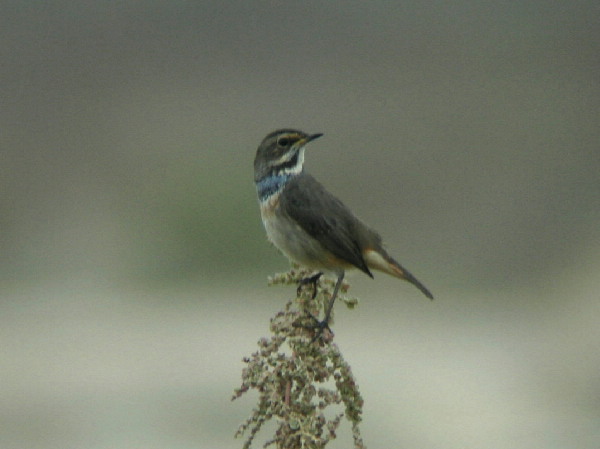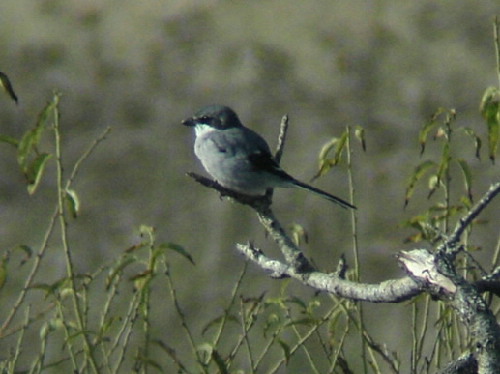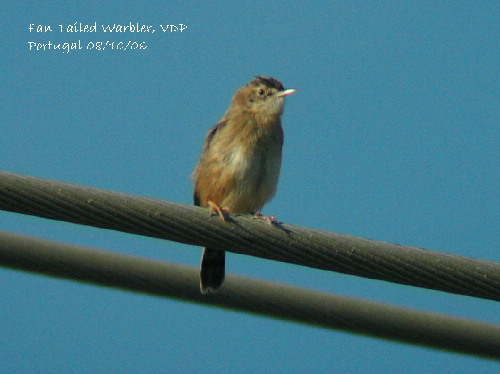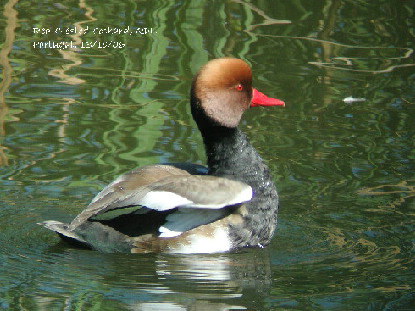Photos with this report (click to enlarge) | |||
 BLUETHROAT |
 SOUHERN GREY SHRIKE |
 FAN TAILED WARBLER |
|
 RED CRESTED POCHARD |
|||
Saturday 7th October:
This is our sixth visit to the Algarve in the autumn, although our first staying at the villa Quinta Terruta, which lies on the Vale de Perra to Armacao de Pera road, overlooking both Salgodos golf course and Pera Marsh.
Arriving in brilliant sunshine about noon on Saturday 7th October and greeted by fluttering Swallowtails, how could we be anything but pleased with Tina's choice of accommodation. Quickly unloading the bins, the view from the balcony revealed a southern grey shrike, hawking dragon flies from an old almond tree , further a field flamingos, white stork, stilts, little and cattle egrets could clearly be seen in large numbers on the salt marsh and golf course. In the vegetation surrounding the villa were willow warbler, singing black caps and Sardinian warbler.
After a quick lunch of sardines at the Coelha Beach hut cafe it was off to Pera Marsh for a twitch. On the water in large numbers were: white stork, grey heron, little egret, cattle egret, black winged stilt, spoonbill, greater flamingo, little and a single black necked grebe, moorhen, coot, gadwall, northern shoveler, mallard, black headed gull, yellow legged gull, lesser black backed gull, kentish plover and cormorant.
In the surrounding fields, brush and fig trees: Willow warbler, sardinian and fan tailed warbler, spotted flycatcher, feral pigeons, collared dove and gold finch. Two kestrels and hoopoe’s flew over. My only disappointment was that as I lifted the camera to snap a spotted flycatcher, it refused to make an exposure, reducing me to digiscoping only, which for me is a bit hit and miss.
Back at the apartment after completing the unpacking and taking a beer on the balcony, a small flight of yellow wagtails flew over. Stonechat, blackbird, crested lark, spotless starling and house sparrow were in the surrounding scrub. A pied flycatcher was in the apartment trees. A single meadow pipit was on the golf course as waders also made their way down to forage on the green in the evening, including common sandpiper. Two white storks made a noisy entrance as they flew on to their nest , high up on the electricity pylons, for the night (as they did every subsequent evening) , banging and rubbing their bills together in a show of affection. A single yellow wagtail was at the water treatment plant.
Butterflies seen today included: Swallowtail, Southern Small White, Speckled Wood, Clouded Yellow and Common Blue Dragonflies included: Emperor, large red and blue damsel fly and brown aeshna.
Sunday 8th October
am - From balcony Black Cap, ChiffChaff and a Fan-tailed Warbler which posed for some time taking the sun on the overhead cables. 2 Hoopoe flew in to the cork oaks to the right of the villa.
pm - In the evening 6 Red Legged Partridge foraged in the scrub and a short visit to the Marsh revealed several Little Terns and Sandwich Terns, plus all the marsh birds previously. A Red legged partridge on the scrub outside the villa
Monday 9th October
am - From the balcony we could see that a large party of Avocet had joined the birds on the marsh, the 2 Hoopoe were again seen in the cork trees and the Grey Shrike on an almond tree with stonechats. In the early morning a Kestrel alighted on a street light near the Golf Course. We decided to visit Quinta da Lago on a warm sunny day with temperatures at about 28c.
The tide was out on the estuary with large numbers of men cockling. Birds seen included Kentish and Grey Plover, Black Tailed Godwit, Whimbrel, Green and Red Shank, Dunlin, Turnstone, Sanderling, Yellow and Lesser Black Headed Gull. A visit to the lake surrounded by the Golf Course, pleasantly surprised us with a party of 6 Glossy Ibis, Little Egret, Grey Heron, Purple Gallinule, Mallard, Shoveller, Tufted Duck, Gadwall, Pochard, Red Crested Pochard, Little Grebe and Kingfisher. Reed Warbler and Cettis Warbler were also present.
A walk down the track through the woods revealed Goldfinch, Pied and Spotted Flycatcher, Azure Winged Magpie, Short Toed Treecreeper, Crested Lark. On the salt pans there were large numbers of Black Winged Stilt, Black Headed Gull, Greater Flamingo, Spoonbill, ducks, coot and moorhen.
On the walk back a nice couple stopped us to query the identity of a couple of waders, during the conversation they mentioned having seen a Bluethroat, across the footbridge on the opposite side of the estuary which we decided to twitch without any real expectation of seeing. Taking the short walk across the bridge and scanning the scrub, after about 15 minutes we were able to spot male and female birds through the scope someway off, however we were quite pleased as this made the journey worthwhile.
Tuesday 10th October
am: Vale de Parra: Awaking early at the sound of a Hoopoe calling outside, I took a short walk in the fields surrounding the villa, again having good views of hoopoe, fan tailed, willow and sardinian warbler, female black cap, spotted flycatcher, both egrets, common sand at the water treatment plant, crested lark, spotless starling, greenfinch, goldfinch, pigeon, collared dove, grey shrike and a kestrel flew over.
A large fall of northern wheatear had also occurred overnight.
Whilst on my walk I met a couple from the Wirral who said that I was the only birder that they had met on their travels. They said that they had been up to Cape St Vincent the previous day and had seen several booted and short toed eagle but little else, although they understood it was good for passage raptors. They said although they were pleased with the birding, they had seen nothing exceptional.
La Rocha: The weather remained fine and warm, with a temperature of 26C. We decided to visit Quinta da Rocha at Alvor, taking a left off the 125 opposite the Maxilhoeira Grande turning, arriving at about 11.30.
Quinta de Rocha means "Farm on the Rock" and hosts a nature reserve supported by the international "A Rocha" conservation movement. If you've never been its worth visiting their centre on Thursday mornings, when the public is invited to attend ringing demonstrations, of birds netted on the reserve. They also offer a reasonably priced guide/bird checklist for Alvor and a cuppa. This week’s edition of Portugal news (English edition) made reference to the fact that the EC was pressing the government to ratify the areas protected status.
Following the track down to the coast , a kestrel hovered over an orchard, willow warblers flew out of the road side scrub and we pulled up to view five azure winged magpies cavorting in the trees also flushing a wood pigeon. A number of great tits were also active amongst the almond and fig trees. On the fencing surrounding the car park stonechats, wheatear and crested lark were prominent.
The marsh areas are cut off from the estuary and sea by a series of clay dykes, the main one of which forms a circular walk, following the sea on the west , the Alvor Estuary in the north and back to the car park by the eastern track. The whole walk takes about two hours if you are birding. Since the tide was out for a couple of miles and the only thing that one could see would be a large number of "cocklers", we opted for a straight walk on the eastern dyke passing the brackish tanks either side. A number of shrubs by the car park, act as good cover for warblers including willow, sardinian, fan tailed, whitethroat, a female blackcap and a single orphean warbler, which proved less skittish than his sardinian cousins. As we approached the path a hoopoe broke cover and flew into the stony field to the right. A mixed flock of waxbills and goldfinch was active amongst the seed baring scrubby plants. To the left of the path there were numbers of: black winged stilts , red shank, dunlin, two kentish plover a single greenshank and about twenty roosting herons. On the eastern pools two curlew sandpiper were wading and on the path wheatear and crested larks. Single oyster catcher and whimbrel flew overhead towards the estuary. All the time we were scanning for Bluethroat which we had seen very briefly last year. Reaching the junction with the northern path our attention was drawn to a number of seed feeding birds on shrubs at the side of the path, initially these proved to be Spanish and house sparrows along with a single highly streaked light coloured finch , which we reluctantly put down as a linnet, for want off another description. Suddenly out popped a male bluethroat followed by a female, both rapidly disappearing. Unfortunately half an hours twitching rewarded us only with brief views of flicking tails. Having given up on the bird as we turned for the walk back. there it was, a singing male out on a bush not five yards away directly in front of us, after a minute or so it flew down onto the mud bank, hopping about along side a dunlin and a ringed plover.
Quite a number of swallow tailed butterflies were about as well as dragon flies. Its true to say that this little display made the day as we headed off to Praia Da Luz to walk the coastal path to Burgau.
Tuesday 10th October
PM: Praia Da Luz to Burgau: The coastal path between Luz (which is about 4 km west of Lagos) and the former fishing village of Burgau , is one of our favourite walks, not least of all because the outward leg culminates with "monkfish with rice" at the Barraca restaurant, overlooking the bay at Burgau. If you like sea food visit and try this delightful fish stew, served up in a clay pot crammed with Monkfish, Prawns, Clams and rice.
Be aware though that building development is ever increasing and spoiling this coastal habitat. Over recent years , in addition to the usual , on this walk we have seen: Grey and Woodchat Shrike, Kingfisher, Dartford Warbler, Lesser Kestrel, Peregrine, Whimbrel, Grey Wagtail, Serin, Azure-winged Magpie and Waxbill so the prospect always excites us.
Erosion of the coastal sandstone can make the walk a little bit tricky in places however we find it rewarding.
Parking in west end of Luz we follow the main rd down to the sea and follow it right at the English pub at the bottom, it is then straight forward just following the well worn path between the two villages. Just out of Luz there are a number of small pits dug into the sandstone bed rock, these are normally good for Grey Wagtail and Grey Shrike, our catching only a brief glimpse of the wagtail as it flew on over the low hills on the right. Wheatear, Crested Larks and Stonechat accompany you for most of the way until the path eventually begins to climb a little, where new build villa's encroach nearer the coast, the area is good for black redstart, which along with blue rock thrush can and did pop up almost anywhere. Sea watching didn't deliver very much other than Tunstone, Shags, Yellow and Lesser Black Backed Gull.
At about half way the path traverses a fenced off farm plot, check the buildings for the resident little owl, under the cliffs at the same point on the way back sat a blue rock thrush. Just before this point a skylark and several fan tailed warblers rose from the side of the large hill with its westward side slipping into the sea( check out for Dartford Warbler in the spring). After about an hour and a half we reached Burgau, where to our disappointment ( it was now 15.30) , the village eateries had stopped serving food - moral, ensure you arrive before 3.00 pm - after a quick beer we were off back again on the return leg. Skirting the gardens of the villas, half a km from Luz, garnered Black bird, blackcap and solitary Monarch butterfly. At this point there is a deep channel which hosts a spring, hidden by pampas grass and reeds . Making my way toward it a flight of waxbills, willow and Sardinian warblers scattered and to my surprise amongst the reeds a great reed warbler flitted about.
Butterflies seen during the walk were Wall and Large Wall Brown, Southern Small White, Clouded Yellow, Swallowtail and Monarch.
Wednesday 11th October
Deciding that today was hardly likely to be a sunbathing day, since we woke up to a thick mist that had descended on Vale Da Parra, we decided to head further up west, to Cape St Vincent. The mist extended for most of the journey only starting to clear at Vale Do Bispo. On reaching the Cape we decided to take a sandy track leading to the Raptor Watch Point, surrounded by pines active with Blue Tits and Greenfinch. Getting out of the car our attention was immediately drawn to a raptor skimming the sierra. A quick spy with the bins showed this to be a female hen harrier. No sooner had we put the bins down than a booted eagle flew out from above the pines as it headed north a massive grey cloud overshadowed our standpoint and started it to rain heavily as a further large dark , but unidentified ,raptor flew out from the trees rapidly disappearing around the other side. Not wishing to get stuck in the mud we decided to head off to the lighthouse at the Cape.
On the telegraph wires running parallel to the cape road were stonechat, spotless starling, southern grey shrike and stonechat.
By the time we arrived at the lighthouse the rain cleared, giving way to sunshine. The cape was as usual busy with tourists, since it is a visiting point for most coach trips. It's spectacular cliffs play hosts to the Portuguese rock fishing anglers who cast their lines from the most precarious and spectacular places, high up on the cliffs. On our last two visits the public have not been allowed access to the Lighthouse courtyard , which is disappointing since it offers the best sea views. After taking a quick cuppa, we scanned the sea , however the only birds visible were gannet, yellow legged and lesser black backed gull. A stork circled overhead, whilst we were hoping for alpine accentor, the surrounding area offered only black redstart, blue rock thrush, sardinian warbler and house sparrows. Taking the first left track off the Sagres road, heading towards Vila do Bispo, the rain came on again both heavy and persistent. We stopped briefly to watch three kestrel hovering over the stony plain, while in the distance a raptor scudded anonymously across the grey sky. In the pine trees to the right two ravens roosted in the rain. Further on past the desolate farm straddling both sides of the track ( in other years we've had yellow and white wagtail, tawny pipit and dotterel here), foraging amongst the rough grasses that prevail , were a large flock of corn bunting , linnet and northern wheatear. A little further on a number of lapwing and spotless starling were feeding together. Half way to Vila do Bispo, farm ruins appear on the left a little owl stood guard as the rain began to ease off. Nearby on a telegraph pole mobbed by greenfinch, corn bunting and a kestrel, a bedraggled common buzzard was shaking itself dry. At the next habited building on the right is well kept small holding, as the sun came we took a short walk and a spotted a nightingale, briefly taking the sun on top of a dense shrub. Deciding to take the tarmac road, turning to the right (marked "50") more wheatears and buntings were about, turning off left at the next cross roads we came across the couple that I mentioned earlier who were scoping two black kites as we opened the car door, a peregrine swooped down from a near bye telegraph pole and swept off into the distance. Disappointingly there was no repeat of last years 20+ Egyptian Vultures on the hill, at that we headed back to the villa.
Pera Marsh: I managed to convince Tina that the day hadn't finished yet so we stopped off at Pera Marsh. Here there were good views of all the previously mentioned marsh birds including large numbers of flamingo, spoonbill and avocet.
Scoping the golf course side of the lake , we picked out a total of three female marsh harriers that had gone to ground, whilst a little gull flew over.
Thursday 12th October
In the morning birds visible from the villa and seen on the Marsh included lapwing, pochard, both green, common and spotted redshanks. In late afternoon stonechat and wheatear were seen.
Deciding on a further visit to Alvor we were soon deterred since we could see a party of about 15 twitching the Bluethroat's residence, so we decided on leaving him alone for now and trying again later on our return journey.
To day turned out a little cooler at 22C, and one way or another our plans failed to materialise . Silves is a lovely old Moorish Castled town. We enjoy walking the path by the river, which can give good views of stork, sandpiper, egret, wagtails, pipits, warblers, heron, kingfisher, waxbill and the occasional marsh harrier, however on this occasion the ancient footbridge, footpaths and main car park were all fenced off for major renovation work - so we drove on for the lunch that we missed at Burgau , monkfish with rice.
We gave the birding a bit of a rest to enjoy the food, noticing gannets out at see (including one poor creature with a fishing line attached) and what looked like a single scaup.
Our decision to check out the plains up at Bispo also proved an error , with Tina (driving) being erroneously directed by me over a extremely rough track, the next stop for which looked like a 200 foot drop into the Atlantic. Backtracking we headed for the town reaching a cross roads , where as we got out for a quick scan a short toed eagle glided not more than 10 metres above us, a couple of lesser kestrels patrolled and again in the distance two large raptors spiralled in the warm afternoon sunshine.
Alvor: Checking out Alvor in late afternoon, we saw little owl in the orchard and on the farm ruins by the car park. Waders were still thin on the ground, this time only black winged stilt, redshank and dunlin putting in an appearance. A large roost on lesser black backed and yellow legged gulls was out on a sandbank in the estuary along with a single whimbrel. We were very pleased to see two Caspian terns put in an appearance, settling in one of the low tide salenas. A few Spanish sparrows were feeding in the same place as before and the bluethroat popped out on the path, briefly cocked his tail as if to say goodbye and disappeared into the vegetation. As we walked back the usual numbers of stonechat, crested lark, wheatear, fantail and Sardinians, and finches were easily seen. We then headed off back "home" as the evening sun illuminated thousands of gossamer like damsel flies.
Friday 13th October (nothing bad happened !)
At the apartment in the morning a hoopoe was back in the cork oak, wheatear and stonechat were on the scrub and single whinchat was on the fence. A few warblers flitted about in the trees and fan tails onto the overhead wires. Early on the storks were rubbing their bills on the pylon nest.
Being packing day to day we opted for a further visit to Quinta do Lago.
On our arrival the tide was half out on another beautiful day.
All the previously listed birds were there, both on the estuary and the golf course reserve. New sightings included two little bittern’s that flew into the reedy islands , a single black-necked grebe, a cirl bunting that briefly appeared on the reeds and a single spoonbill that had joined all the throng visible from the hide on the golf course lake. We were kept entertained in there for an hour or so by a couple of half birders/golfers from Macclesfield. Occasionally joined by curious folk , not one bit impressed with the ibis, but bowled over by the “funny ducks with red bills” that they wanted to be able to put a moniker on.
In Conclusion: (safe and sound back home on Saturday afternoon 14th October 2006)
Well there it was, at a guess that something like 100 species seen, but more than that we enjoy the Algarve since English is widely spoken the food and the wine are great, and the birds are the icing on the cake. The sad side is that more and more retirement villas, holiday homes and golf courses are encroaching on habitats, therefore if you have never been , try it now before it is too late.
It's is fair to say that the weather was more consistently warm and fine than we have previously experienced, which is perhaps not the best for bird watching. Also this is the first year in trips to the Algarve that we have never seen a single hirundine. Other years there have still been swallows, martins - house, sand and crag as well as Alpine and Common Swift. What happened there I don’t know, since there were still one or two about when we left home, although not on our return. We also decided to give Castro Verde a miss this year, since in October, we have only ever seen Great Bustards from distance and its virtually a full day out with little else to show for it, since we’ve never caught up with sandgrouse of either species. Whilst one year we saw so many stone curlew we thought that they might be common, subsequent years we have not seen any. It is practically the same with black shouldered kite which we saw for three years on the trot, but not for the last two. The most obscure sighting that we ever had in Portugal ,was an African red billed quelea bird grazing with some house sparrows down on the green at the Quinta golf course.
Every year we consider doing this in the spring, however Lesbos has so far won out every time - roll on May !
Oh and finally if you do nothing else, try the monkfish with rice at the Barraca in Burgau.
Avocet
Blackbird
Blackcap
Bittern Little
Bluethroat
Bunting Cirl
Bunting Corn
Buzzard Common
Coot
Cormorant
Dove Collared
Duck Gadwall
Duck Pochard
Duck Pochard
Duck Tufted
Duck Mallard
Duck Shoveler
Dunlin
Eagle Booted
Eagle Short Toed
Egret Little
Falcon Peregrine
Falcon Red Footed
Flamingo Greater
Flycatcher Spotted
Flycatcher Pied
Gallinule Purple
Gannet
Godwit Bar Tailed
Godwit Black Tailed
Goldfinch
Grebe Little
Grebe Black Necked
Greenfinch
Greenshank
Gull Black Headed
Gull Lesser Black Backed
Gull Little
Gull Yellow Legged
Harrier Hen
Harrier Marsh
Heron Grey
Hoopoe
Ibis Glossy
Kingfisher
Kite Black
Kestrel
Kestrel Lesser
Lapwing
Lark Crested
Lark Sky
Linnet
Pigeon Wood
Magpie Azure Winged
Moorhen
Nightingale
Owl Little
Oystercatcher
Partridge Red Legged
Plover Grey
Plover Kentish
Plover Little Ringed
Plover Ringed
Raven
Redshank
Redshank Spotted
Redstart Black
Robin
Rock Thrush Blue
Sandpiper Common
Sandpiper Curlew
Shag
Shrike Southern Grey
Snipe Common
Sparrow House
Sparrow Spanish
Spoonbill
Starling Spotless
Stilt Black Winged
Stint Little
Stonechat
Stork White
Tern Caspian
Tern Little
Tern Sandwich
Tit Blue
Tit Great
Treecreeper Short Toed
Turnstone
Wagtail Yellow
Warbler Cetti's
Warbler Fan Tailed
Warbler Reed
Warbler Great Reed
Warbler Sardinian
Warbler Willow
ChiffChaff
Wheatear Northern
Waxbill
Whitethroat
Whimbrel
Winchat
101 species